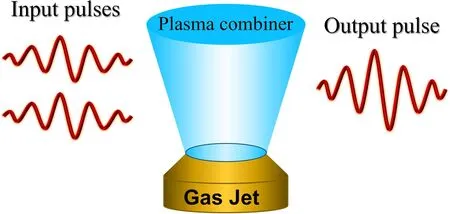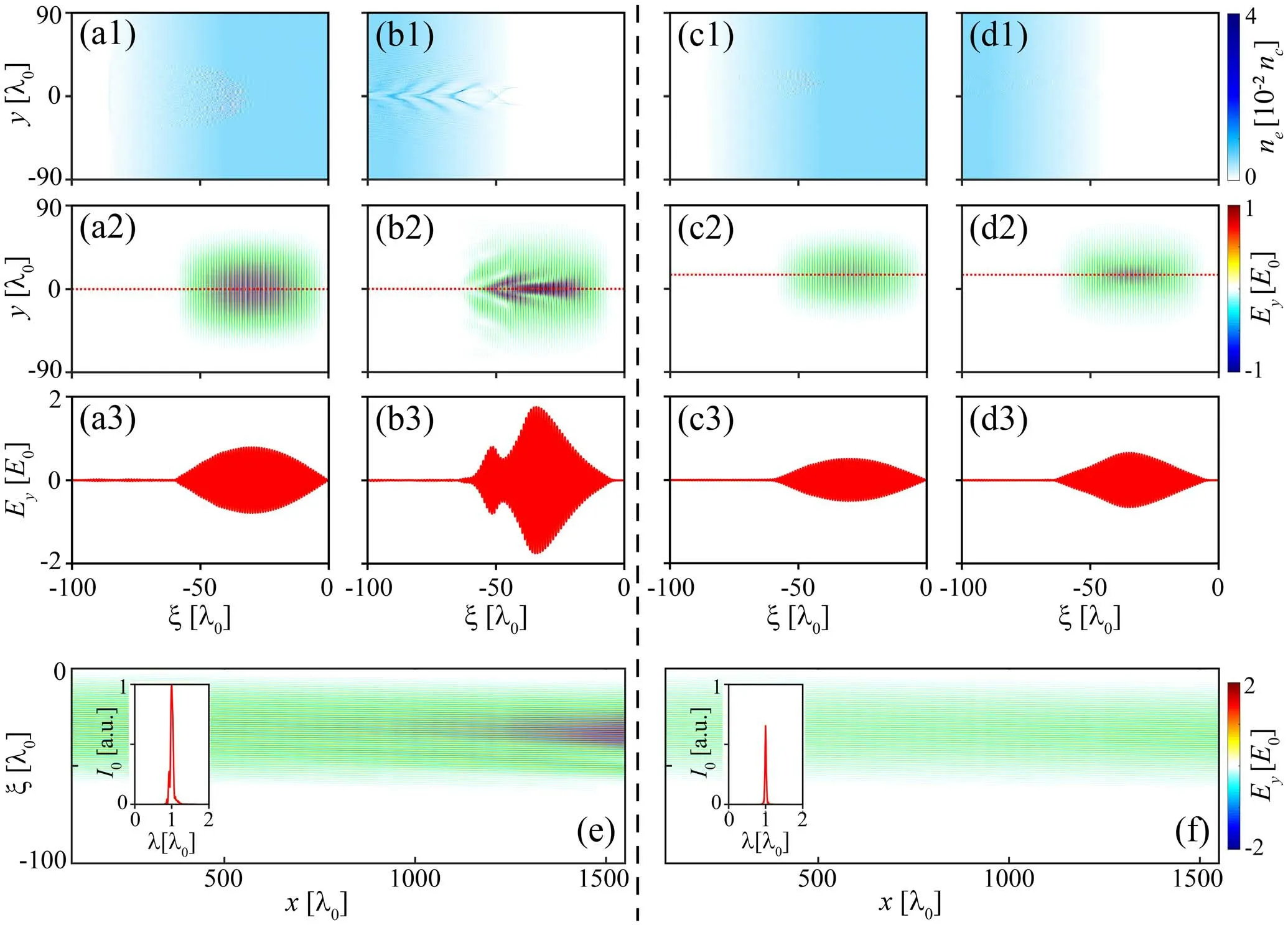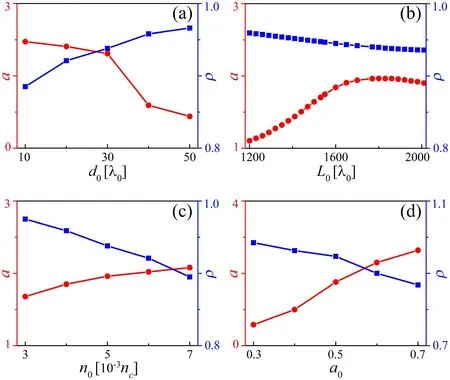Efficient combination and enhancement of high-power mid-infrared pulses in plasmas
2023-03-06XinglongZHU朱兴龙
Xinglong ZHU (朱兴龙)
1 Tsung-Dao Lee Institute,Shanghai Jiao Tong University,Shanghai 200240,People’s Republic of China
2 Collaborative Innovation Center of IFSA,Shanghai Jiao Tong University,Shanghai 200240,People’s Republic of China
Abstract High-power intense optical sources in the mid-to-long wavelength infrared region are very attractive for a wide range of fields from fundamental research to materials science and biology applications.However,there are still significant challenges in extending long-wavelength infrared pulses into the relativistic regime using conventional optical techniques.Here,based upon a new type of plasma-based optical method,we present an efficient scheme capable of combining several high-power long-wavelength infrared laser pulses into one single,more intense pulse,thus bringing the intensity of the output pulse to the relativistic regime.Such intense infrared pulses will open up new possibilities for strong-field physics and ultrafast applications.Furthermore,this is beneficial to understand the underlying physics and nonlinear processes of modulation,propagation and energy transfer of high-power intense laser pulses in plasmas.
Keywords: laser plasma interaction,infrared pulses,plasma optics,pulse modulation,energy transfer
1.Introduction
High-power intense mid-infrared pulses are of particular interest in a broad range of scientific fields due to their important role in strong-field physics [1,2],bright high-harmonic generation[3],filamentation[4],time-resolved imaging of ultrafast molecular dynamics and structures[5],and infrared spectroscopy [6].Many of these applications would highly benefit from the long carrier wavelength,intense field strength and high pulse energy,because the ponderomotive electron energy and the emitted photon energy are roughly scaled toI0,whereI0andλ0are,respectively,the peak intensity and the carrier wavelength of the driving optical fields.However,for current ultrafast laser technology,it is still challenging to simultaneously attain these conditions.When the long-wavelength infrared pulses reach relativistically high intensity and/or multi-TW high power,they will open new avenues for investigating strong-field light-matter interactions [7],laserplasma acceleration [8],and hard x-ray attosecond pulse generation[9].Over the past decade,significant progress has been made in the development of high-power intense mid-infrared pulses by using various nonlinear optical materials[10-13],but it is difficult to achieve high-energy infrared sources in the spectral range of above 5 μm,especially for extending their intensities into the relativistic regime.
In recent years,plasma-based optical methods have attracted a lot of interest in the generation of high-power highintensity optical pulses [14-17],since there is no damage limitation in the plasma.This suggests that the plasma-based approach can sustain more intense laser pulses with much higher power and higher intensity than traditional nonlinear crystals.Furthermore,high-power infrared pulses generated by plasma methods can be extended to wavelengths above 10 μm,i.e.to the mid-to-long wavelength infrared frequency range.It is still challenging to achieve these with conventional optical techniques such as chirped mirrors.Several novel concepts for relativistically intense few-cycle infrared light pulses have been recently proposed and/or demonstrated experimentally[18-24],but their spectra are quite broad and their peak powers are typically limited to the sub-TW range.Efforts continue to develop tunable intense long-wavelength infrared sources with relativistic intensity,narrow spectrum and high power in the multi-TW range,which are desired for many cutting-edge applications.
In this paper,we introduce an efficient way of plasmabased optical modulation to solve this intriguing quest.This is attained by merging several driving pulses into a single output pulse,which leads to remarkable increase in the power and intensity of the output pulse.Moreover,the resultant pulse will also undergo strong self-focusing during the interaction.As a consequence,more intense long-wavelength infrared pulses can be obtained while maintaining a narrow spectrum similar to that of the driving pulses.Although this may lead to a broader spectrum of infrared pulses than conventional optical techniques,it enables the light pulse intensity to be expanded to the relativistic regime.
2.Physical scheme
3.Results and discussions
3.1.Efficient combination and enhancement of high-power infrared pulses in underdense plasmas
We now investigate the physical processes of plasmabased optical combinations occurring in this scheme.Figure 2 illustrates the evolution of the plasma density,the laser pulse and the transverse electric field.Two driving laser pulses,with30λ0transverse distance between their propagation axis,are irradiated into an underdense plasma,where they experience strong interaction and induce nonlinear effects such as plasma density modification and relativistic nonlinearity.In the earlier stage of the interaction process,both the transverse field and the plasma wave are relatively weak,as seen in figure 2(a).As the two pulses propagate in plasmas and undergo self-focusing individually,they appear to attract each other in this process.After an interaction distance of about 1500λ0,the two driving pulses are merged into a single pulse with high field strength reaching about1.8E0more than three times higher than that (0.5E0) of the initial laser pulse,as displayed in figure 2(b).In comparison,the field strength can only be amplified to about0.6E0in the one pulse scheme,as seen in figure 2(d).It should be noted that when two highpower drive pulses are combined into a single pulse with relativistically high intensity,a nonlinear plasma wake is excited,leading to stronger self-focusing and nonlinear effects,which in turn change the profile of the output pulses.Nevertheless,the distinct advantage of this scheme for enhancing high-power infrared pulses is that,unlike ultrabroadband spectrum radiation in previous plasma-based methods [19-24],the resulting pulses have a relatively narrow spectrum with a central wavelength around 10λsimilar to that of the driving laser pulse,as shown in figure 2(e).The FWHM spectral width of the output pulse increases only from 0.03 to 0.08 compared to the initial input pulse.This makes it possible to obtain relativistically intense infrared pulses while maintaining narrow spectral characteristics.

Figure 1. Schematic diagram of high-power infrared pulseamplification using a plasma-based optical combiner.In this scheme,the energy of two input infrared pulses can be efficiently combined into a single pulse beam,thus greatly enhancing the light intensity and power of the output pulse.

Figure 2.Distributions of the electron density,the transverse electric field of the evolved laser pulse and its on-axis electric field are shown at the beginning of the plasma combiner (a) and at the end of the combiner (b) with two driving pulses.The corresponding distributions are shown in((c)and(d))with a single driving pulse.Evolution of the on-axis electric field as a function of the propagation distance in the twopulse case (e) and in the single-pulse case (f).The red dashed lines in ((a2)-(d2)) indicate the positions of the on-axis electric fields.The insets in ((e) and (f)) display the spectral distributions of the output infrared pulses.

Figure 3.Effects of(a)the transverse distance(d0)between the two driving laser pulses,(b)the length(L0)of the uniform density part,(c)the plasma density(n0),and(d)the driving laser intensity(a0)on the normalized intensity(a)and energy efficiency(ρ)of the output infrared pulses.Here,ρ represents the ratio of the output infrared pulse energy to the input driving pulse energy.
For comparison,we also investigate the case of one driving laser pulse propagation in plasmas,while all other parameters are the same as those in the two-pulse case presented in figure 2.The findings indicate that one driving pulse can be still self-guided and propagated over a long distance in plasmas owing to its peak power exceeding the critical threshold 3.4 TW,but both the pulse self-focusing and plasma wave excitation are much lower than those in the two-pulse case,as shown in figures 2(c)and(d).This is attributed to the relatively weak nonlinear effects and ponderomotive force induced by one laser pulse.As a consequence,the evolution of the laser pulse propagating in plasmas is quite moderate with only a small increase in light intensity,as shown in figure 2(f),making it unsuitable for achieving high-power relativistically intense infrared pulses.
3.2.Effects of the laser and plasma parameters on the output infrared pulses
To demonstrate the robustness of the proposed scheme,we consider the effects of the drive laser pulse and plasma target parameters on the combination and enhancement of the infrared pulses in plasmas.We first investigate the effect of the transverse distance (d0) between the two drivers on the pulse amplification in figure 3(a).The results show that the interval distance between two drive pulses should not be too large,otherwise they do not attract and combine well together.For example,whend0≥40μm,the intensity of the combined light pulse will be lower than the relativistic intensity.On the other hand,while a smaller pulse spacing is beneficial to achieve more intense combined light pulses,this may prematurely excite stronger nonlinear and relativistic effects,leading to a decrease in the conversion efficiency of the pulse amplification.Therefore,the optimal distance should be slightly less than30μm,which is approximately the focal spot size of the driving laser pulse.
Figure 3(b)illustrates the effect of the longitudinal length of the uniform density part of the plasma combiner on the resultant infrared pulse,where the plasma length (L0) is changed in the range from 1200λ0to2010λ0,while keeping all other parameters unvaried.It is shown that an appropriately long plasma length is beneficial for pulse attraction and combination,because the mutual interaction of optical pulses in plasmas and their nonlinear coupling effects become more strong.This allows the light intensity of the output infrared pulse to increase with the length of the plasma target.Nevertheless,the plasma length should not be too long;otherwise,it will cause significant pulse depletion or attenuation due to strong absorption.The simulation results show that the optimal plasma length is aboutL0=1800λ0for high-efficiency intense infrared pulse amplification in the considered parameter conditions.
Figure 3(c) presents the effect of the plasma target density on the infrared pulse amplification,which is varied from 3 × 10-3ncto 7 × 10-3nc.Based on the critical power model that is inversely proportional to the plasma density asGW ∝nc/ne,when using a higher density,one can obtain a lower power threshold for self-focusing,so that the mutual interaction and focusing effects of laser pulses and the plasma wave excitation become stronger according to equations (1) and (2).This is demonstrated by our PIC simulations,where one can observe that the intensity of the enhanced infrared pulses increases with the plasma density,as exhibited in figure 3(c).It should be noted that the energy efficiency of the output infrared pulse decreases with increasing plasma density due to the strong interaction between the laser pulse and the plasma resulting in a large amount of pulse energy being absorbed.
The effect of the driving laser intensity on the pulse amplification is illustrated in fgiure 3(d).Here all other parameters are the same as those presented in the two-pulse case in figure 2,except for the driving laser amplitudea0,which changes in the range from 0.3 to 0.7.One can see that the normalized amplitude of the output infrared pulse is approximately proportional to that of the driving pulses.This is because the effects of the ponderomotive force,plasma density modification,and relativistic nonlinearity are mainly determined by the driving laser intensity.Interestingly,even using two non-relativistic driving laser pulses witha0= 0.4,it is still possible to obtain a relativistic-intensity output pulse via our scheme.This is due not only to the pulse merging effect,but also to the relativistic self-focusing of the amplifeid infrared pulse itself in the plasma.More importantly,about 95%of the total energy of the two drive pulses can be effectively combined into a single output pulse.Nevertheless,it is worth noting that the drive laser intensity should not be raised to an arbitrarily high value,e.g.,fora0> 0.7;otherwise,a lot of pulse energy will be absorbed and/or transferred to the plasma wave,and strong nonlinear coupling effects may damage the performance of the output pulse.In addition to these effects,electron injection,acceleration,and radiation may occur at high intensities [32,33],we will not discuss these in detail here,because they are beyond the scope of this paper.
4.Conclusion
In conclusion,we have proposed and numerically demonstrated a promising and efficient scheme to combine two highpower infrared pulses into one single,more intense pulse,so that the light intensity of the output pulse can enter the relativistic regime.The findings show that the output infrared pulses can be flexibly tuned by varying the driving laser and/or plasma target parameters,where more than 90% of the driving pulse energy can be converted into the output pulses.This scheme provides a robust and practical method for efficient combination and enhancement of high-power longwavelength infrared pulses in underdense plasmas,enabling a new regime of relativistic intensity and monochromatic spectrum.Such intense infrared pulses may open new possibilities for a variety of applications from fundamental research to materials science and biomedicine.
Acknowledgments
This work was supported by the National Postdoctoral Program for Innovative Talents of China (No.BX20220206).Thanks for the useful discussion with Prof Z M Sheng.
ORCID iDs
杂志排行
Plasma Science and Technology的其它文章
- Realization of Te0>10 keV long pulse operation over 100 s on EAST
- Solving Poisson equation with slowingdown equilibrium distribution for global gyrokinetic simulation
- Experimental studies of cusp stabilization in Keda Mirror with AXisymmetricity (KMAX)
- BITS: an efficient transport solver based on a collocation method with B-spline basis
- Comparing simulated and experimental spectral line splitting in visible spectroscopy diagnostics in the HL-2A tokamak
- Optimization of X-mode electron cyclotron current drive in high-electron-temperature plasma in the EAST tokamak
